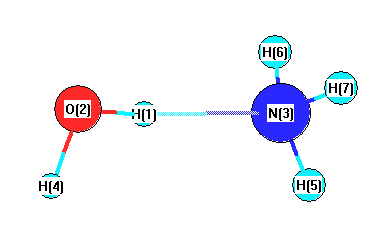Vibrational Frequencies calculated at CCSD(T)/6-31G*
| Mode Number |
Symmetry |
Frequency
(cm-1) |
Scaled Frequency
(cm-1) |
IR Intensities
(km mol-1) |
Raman Act
(Å4/u) |
Dep P |
Dep U |
|---|
| 1 |
A' |
3813 |
3669 |
|
|
|
|
| 2 |
A' |
3630 |
3493 |
|
|
|
|
| 3 |
A' |
3582 |
3446 |
|
|
|
|
| 4 |
A' |
3445 |
3314 |
|
|
|
|
| 5 |
A' |
1793 |
1725 |
|
|
|
|
| 6 |
A' |
1742 |
1676 |
|
|
|
|
| 7 |
A' |
1211 |
1165 |
|
|
|
|
| 8 |
A' |
445 |
428 |
|
|
|
|
| 9 |
A' |
203 |
195 |
|
|
|
|
| 10 |
A' |
168 |
161 |
|
|
|
|
| 11 |
A" |
3582 |
3446 |
|
|
|
|
| 12 |
A" |
1738 |
1672 |
|
|
|
|
| 13 |
A" |
697 |
670 |
|
|
|
|
| 14 |
A" |
151 |
146 |
|
|
|
|
| 15 |
A" |
7 |
7 |
|
|
|
|
Unscaled Zero Point Vibrational Energy (zpe) 13103.6 cm
-1
Scaled (by 0.9621) Zero Point Vibrational Energy (zpe) 12606.9 cm
-1
See section
III.C.1 List or set vibrational scaling factors
to change the scale factors used here.
See section
III.C.2
Calculate a vibrational scaling factor for a given set of molecules
to determine the least squares best scaling factor.
Charges, Dipole, Quadrupole and Polarizability
Charges from optimized geometry at CCSD(T)/6-31G*
Charges (e)
| Number |
Element |
Mulliken |
CHELPG |
AIM |
ESP |
| 1 |
H |
0.500 |
|
|
|
| 2 |
O |
-0.935 |
|
|
|
| 3 |
N |
-1.025 |
|
|
|
| 4 |
H |
0.411 |
|
|
|
| 5 |
H |
0.347 |
|
|
|
| 6 |
H |
0.351 |
|
|
|
| 7 |
H |
0.351 |
|
|
|
Electric dipole moments
Electric dipole components in Debye
(What's a Debye? See section
VII.A.3)
| |
x |
y |
z |
Total |
| |
1.332 |
-3.943 |
0.000 |
4.162 |
| CHELPG |
|
|
|
|
| AIM |
|
|
|
|
| ESP |
|
|
|
|
Electric Quadrupole moment
Quadrupole components in D Å
| Primitive |
|---|
| | x | y | z |
|---|
| x |
-11.301 |
3.732 |
0.008 |
| y |
3.732 |
-12.030 |
0.020 |
| z |
0.008 |
0.020 |
-13.291 |
|
| Traceless |
|---|
| | x | y | z |
|---|
| x |
1.359 |
3.732 |
0.008 |
| y |
3.732 |
0.266 |
0.020 |
| z |
0.008 |
0.020 |
-1.625 |
|
| Polar |
|---|
| 3z2-r2 | -3.250 |
|---|
| x2-y2 | 0.729 |
|---|
| xy | 3.732 |
|---|
| xz | 0.008 |
|---|
| yz | 0.020 |
|---|
|
Polarizabilities
Components of the polarizability tensor.
Units are
Å
3 (Angstrom cubed)
Change units.
| |
x |
y |
z |
| x |
0.000 |
0.000 |
0.000 |
| y |
0.000 |
0.000 |
0.000 |
| z |
0.000 |
0.000 |
0.000 |
<r2> (average value of r
2) Å
2
| <r2> |
58.764 |
| (<r2>)1/2 |
7.666 |
